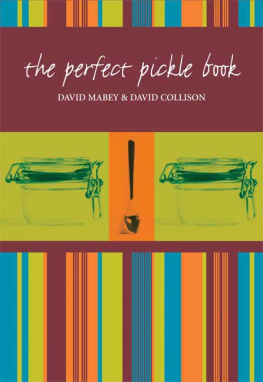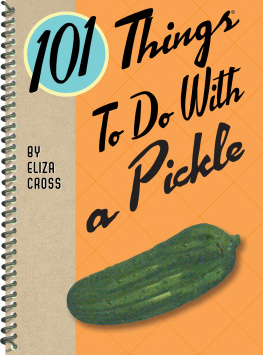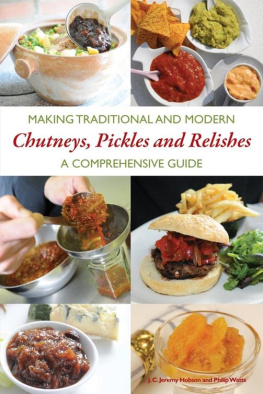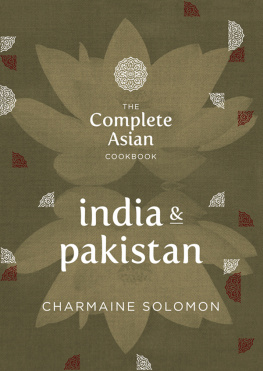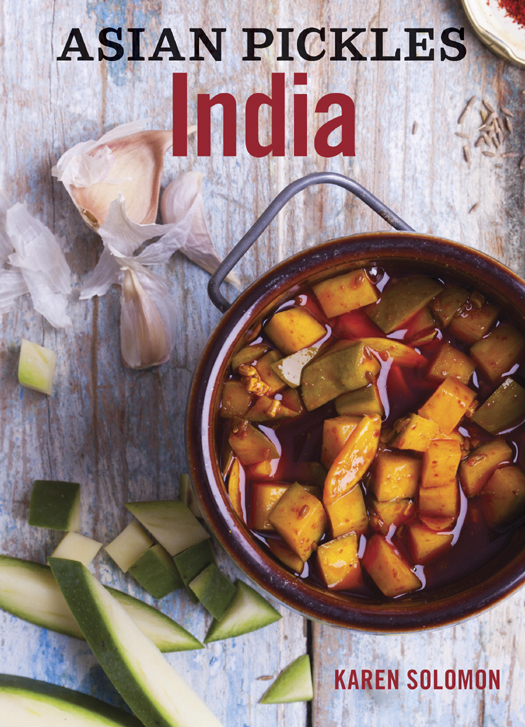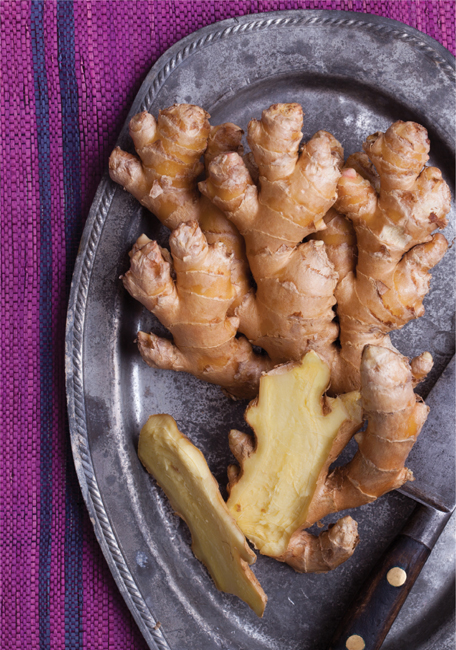2013 Ten Speed Press ebook Original
Copyright 2013 by Karen Solomon
Photographs copyright 2013 by Jennifer Martin
All rights reserved.
Published in the United States by Ten Speed Press, an imprint of the Crown Publishing Group, a division of Random House LLC, a Penguin Random House Company, New York.
www.crownpublishing.com
www.tenspeed.com
Ten Speed Press and the Ten Speed Press colophon are registered trademarks of Random House LLC.
eBook ISBN: 978-1-60774-481-8
Food styling by Karen Shinto
Prop styling by Christine Wolheim
v3.1
Other Cookbooks by Karen Solomon
Jam It, Pickle It, Cure It: And Other Cooking Projects
Can It, Bottle It, Smoke It: And Other Kitchen Projects
EBOOKS IN THIS SERIES
Asian Pickles: Japan
Asian Pickles: Korea
Asian Pickles: China
FORTHCOMING PRINT BOOK IN THIS SERIES
Asian Pickles: Sweet, Sour, Salty, Cured & Fermented Preserves from Korea, Japan, China, India, and Beyond (June, 2014)
VISIT WWW.KSOLOMON.COM
Contents
Introduction
Yoga, chess, the Beatles cosmic conversion, henna tattoos, Bhangra-Indian culture and innovation (as well as Indian food) can be rather polarizing: you either love it or you dont. For me, its a no-brainer: the ghee-rich, amply spiced curries of North India are the ideal method for vegetable and meat intake and Id walk a mile for vindaloo (which, by the way, originated as a pickle of pork with spices in mustard oil and palm vinegar). But the heavy spicing of Indian food in generaland Indias preserves in particularisnt just a matter of taste. With more than 1.2 billion mouths to feed and a blazingly hot climate that can spoil fresh food in a flash, Indias cuisines rely on shrewd food preservation, where pickling and spices play a big role. Thus, the humble pickle, paragon of preservation, is an ever-present and indispensible part of the meal.
Few pickles can compare to Indias for intensity and richness of flavor. Indian pickles are fermented and vinegared, cooked and raw, spicy and sweet and sour. Fruits and vegetables mingle with mass quantities of aromatic spices, toasted fresh to coax out their full flavor. Oil and coconut make them feel lush.
SPICE ESSENTIALS
While most of the ingredients in this book can be found just about anywhere, many of the spices will not be found at your local grocery. Believe me, I wouldnt ask you to make any special purchases unless it was absolutely necessary, but Indian spices are so central to these recipes that they simply have no substitutes. If you have an Indian grocer near you, youre in luckand a high volume market means fresh spices. If not, online sources such as iShopIndian.com, IndianFoodsCo.com, or Amazon.com make it quick and easy to pack the pantry.
Up until now, your familiarity with Indian pickles may both begin and end with the British versionsMajor Greys chutney and Branston Pickle (or ploughmans pickle). Both are delicious in their own right (in fact, I even have a recipe for ploughmans pickle in Can It, Bottle It, Smoke It ). They are a wonderful start to an Indian pickle conversation, but they are by no means the period at the end of its sentence.
Ive tried to pack in a wide sampling of flavors and styles from across the subcontinenta generous tasting plate (better known as a thali ) of recipes. Some are found everywhere in India, such as , a style of preparation most popular in the north.
WHATS THE DIFFERENCE BETWEEN A PICKLE AND A CHUTNEY?
Thanks for asking! Short answer: Its not entirely clear. Long answer: An Indian pickle often implies that the preserve has to sit for a long period, either to ferment or simply to meld flavors and/or textures. Traditionally, a pickle is often cured in oilusually mustard oil. Chutneys, by contrast, are often made fresh to be eaten straight away. But both pickles and chutneys can be either fresh or cooked, though the term chutney can also apply to a dried spice mixture, such as . In general, pickles tend to store longer, while some of the chutney recipes dont last more than a day or two.
Since were chatting about semantics, its worth mentioning that Indians also enjoy sweet preserves, either spoonable or bite-size, made from gooseberries most commonly, but also mangos, carrots, potatoes, dates, and other vegetables and fruits (such as the ).
Ingredients
Ajwain The small, flat seeds of ajwain have a delightful flavorimagine a marriage of thyme, oregano, dill, and cumin. They give an excellent herby backbone to pickles. If you dont have ajwain, use a mix of thyme and cumin seeds instead.
Asafetida You know how a really well-ripened cheese has an odor that, to some, is purely foul? Some foods just have a challenging olfactory aspect, and Indian food tastes like Indian food in large part because of the hard-boiled-egg savoriness of asafetida. This resinous plant gum is very popular in religious sects that dont allow for onions or garlic, as it packs some of their pungency. It used to be that asafetida was only available in dried clumps that had to be pounded or ground before use. Nowadays, it comes in powdered form (usually mixed with rice or wheat flour to keep it from clumping), and this is the sort I used to measure for these recipes.
Cayenne Pepper Dried and ground cayenne pepper can vary widely in taste and heat, depending on the peppers themselves and also the age of the product. I strongly suggest tasting a tiny bit of the powder before using to adjust the heat level to your taste buds.
Chiles and Chile Powder While the tiny and powerful fresh birds eye chiles are the ones most authentic to Indian cuisine, they can often be difficult to find here in the West. So in this book I chose to use jalepeos, Fresnos, and serranos whenever fresh chiles are needed. When it comes to dried and ground chile powder, we have a couple of options. Theres cayenne pepper, sold dried and ground in the spice section and widely available, and this is considered one of the hotter dried and ground peppers (see note above). But the spice aisle also stocks chile powder, which is a blend of peppersoften cayenne is in the mixand this combination tends to not be quite as hot. For the recipes in this book, look for a chile powder that contains only chilethis is the sort youll see at Indian markets. Dont use a Latin American chili powder, as this can also contain cumin, salt, oregano, and/or garlic.
Cilantro see Coriander
Coriander Coriander is like the Swiss Army knife of culinary plants. The root is used in Thai cuisine to add fresh flavor without the telltale green color. But fresh coriander leafknown here as cilantrois the part of the plant we tend to use most, appearing in Indian and many other Asian cuisines, as well as Latin American and Middle Eastern cooking. Its leaves add a mass of big, bright herbacious flavor when eaten raw or stirred into a soup or curry just before serving. When that green plant goes to seed and dries, it can be used as coriander seeddelicious lemony orbs that burst in your mouth, providing both great flavor and texture for the pickle jar. For the same flavor without the crunch, ground and dried coriander seed is also used in cooking, but Ive found that this spice tends to lose its freshness fairly quickly in its powdered form.


